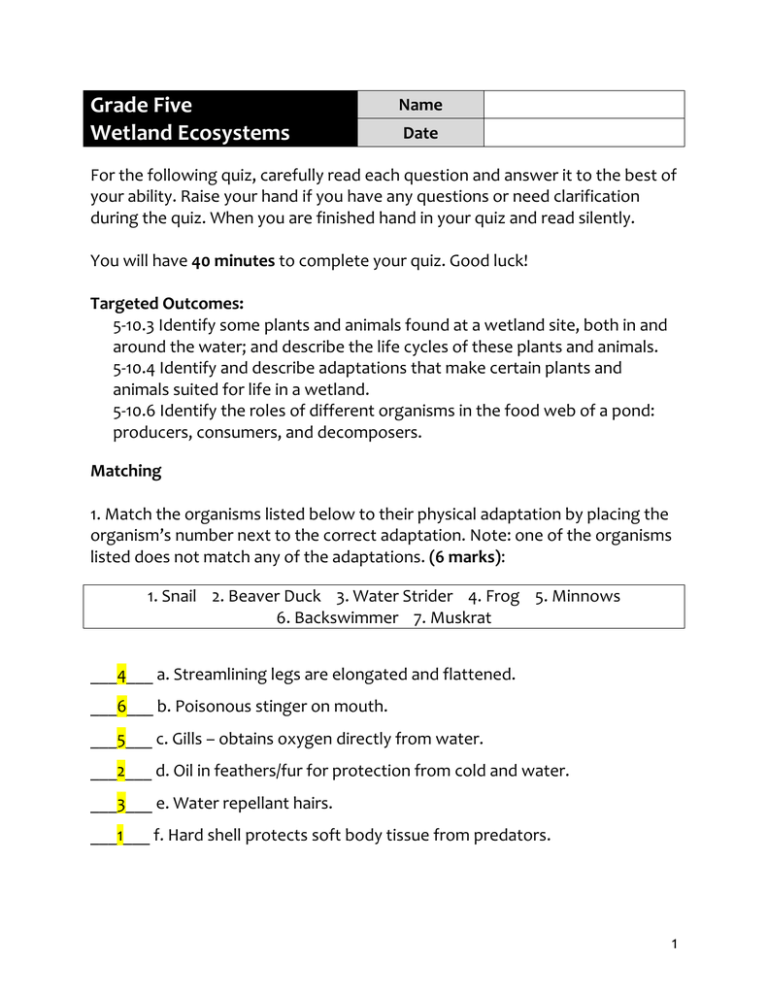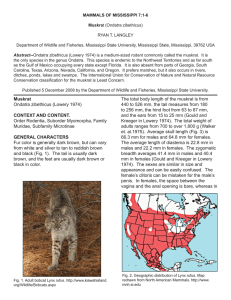File
advertisement

Grade Five Wetland Ecosystems Name Date For the following quiz, carefully read each question and answer it to the best of your ability. Raise your hand if you have any questions or need clarification during the quiz. When you are finished hand in your quiz and read silently. You will have 40 minutes to complete your quiz. Good luck! Targeted Outcomes: 5-10.3 Identify some plants and animals found at a wetland site, both in and around the water; and describe the life cycles of these plants and animals. 5-10.4 Identify and describe adaptations that make certain plants and animals suited for life in a wetland. 5-10.6 Identify the roles of different organisms in the food web of a pond: producers, consumers, and decomposers. Matching 1. Match the organisms listed below to their physical adaptation by placing the organism’s number next to the correct adaptation. Note: one of the organisms listed does not match any of the adaptations. (6 marks): 1. Snail 2. Beaver Duck 3. Water Strider 4. Frog 5. Minnows 6. Backswimmer 7. Muskrat ___4___ a. Streamlining legs are elongated and flattened. ___6___ b. Poisonous stinger on mouth. ___5___ c. Gills – obtains oxygen directly from water. ___2___ d. Oil in feathers/fur for protection from cold and water. ___3___ e. Water repellant hairs. ___1___ f. Hard shell protects soft body tissue from predators. 1 Multiple Choice: circle the best answer. 1 mark each. 2. Many birds live in wetlands. A characteristic that is not an adaptation to facilitate life in the wetlands is A. B. C. D. hollowed bones oiled feathers webbed feet long legs Use the following food chain to answer questions 3 and 4. The direction of the food chain indicates the direction of energy flow. Sun algae water fleas damselfly nymph stickleback fish bacteria 3. In this diagram, the A. B. C. D. bacteria is a producer algae is a decomposer damselfly nymph is a primary consumer stickleback fish is a secondary consumer 4. If you were to add another decomposer to this food chain, you could add A. horsefly B. waterlily C. mushrooms D. fairy shrimp __________________________________________________________________ 5. A plant adaptation that you would not expect to see in a wetland would be A. B. C. D. hollow stems long, thin leaves thick, fleshy leaves short, fibrous roots 2 Use the following information to answer question 6. Megan made a life cycle diagram of an organism that could be found in a wetland. She forgot to add one stage to her diagram. 6. The stage missing from Megan’s diagram is A. B. C. D. eggs pupa larva adult Short Answer 7. Ethan drew a picture of a pond for science class. In his picture he included a duck, marsh hawk, duckweed, and some flat worms. a. In Ethan’s drawing what is the producer? (1 mark) Duckweed b. What two characteristics allow you to know it is a producer. (2 marks) Duckweed is a plant and produces its own food. It gets its energy from the sun. 3 8. Label each stage of the following life cycles. (2 marks per life cycle = 0.5 marks per life cycle stage) egg, tadpole, pollywog, adult a. b. egg, larva or maggot, pupa, adult 4 9. Using the organisms listed in the box, create a food chain containing a producer, primary consumer, secondary consumer and a decomposer. You can only use each organism once. The direction of the food chain indicates the direction of energy flow. (4 marks) Bulrush, Flatworm, Redwinged Blackbird, Duckweed, Dragonfly, Copepod, Muskrat, Stonewart, Moss, Marsh Hawk, Water Beetle, Weasel, Mayfly, Leech, Fisher-spider, Scud Sun Producers Primary Consumers Bulrush Duckweed Moss Mayfly Muskrat Redwinged Blackbird Water Beetle Stonewart Secondary Consumers Dragonfly Fish-spider Marsh Hawk Decomposers Weasel Scud Copepod Flatworm Leech 10. For the following organisms, label one of the two adaptations indicated, and write a sentence to explain how that adaptation allows the organism to survive in a wetland environment. (2 marks each = 4 marks) a. Waterlily 5 Leaf shape displaces water. This allows the leaf to float on the surface of the water where it can easily absorb sunlight. Long, hollow stem. This allows for oxygen to be easily transported to the roots, plant can survive in deep water. b. Muskrat Thick fur. Repels water and keeps the animal warm while swimming. Partly webbed feet. Allow the animal to paddle through the water efficiently, requiring less energy. /26 6







